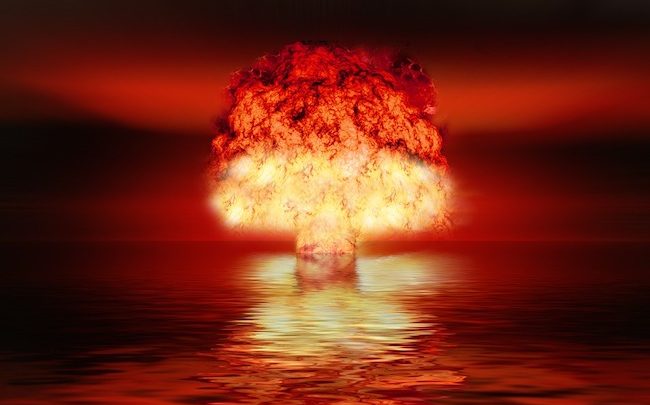
By M Waqas Jan
Over the last two weeks, much has been written about the release of the US’s latest Nuclear Warfare Doctrine that was published on the US Joint Chiefs of Staff’s official website earlier this month. While the sensitivity of the topic and the timing of its release are in themselves cause for discussion, the fact that the document was removed from the public domain after being up for less than a week has fueled intense speculation on whether it was made public by mistake before being abruptly redacted from the JCS website.
The Document titled ‘Joint Publication 3-72: Nuclear Operations’ (dated 11 June 2019) had been uploaded on the publicly accessible section of the JCS’s online library alongside a series of publications self-styled as outlining the fundamental principles of US military action and decision-making. It represents the first official stance on the US’s use of Nuclear Weapons in over 14 years, which either ironically or perhaps deliberately has courted similar controversy over its release much in the same way the last version of this document did back in 2005.
That was when a similar manual bearing the same title had been leaked by the Washington Post as an unapproved revision of the US Nuclear Doctrine. A year after the leak in 2006, the Pentagon had announced that it was cancelling the publication of this revision and had also removed the earlier 1995 version of this document from its website. Titled Joint Publication 3-12: Joint Nuclear Operations, this earlier version had otherwise remained in the public domain for about a decade since it was first released in 1993 and subsequently revised in 1995.
In order to add a bit of context to what they cover, these documents filed under the Department of Defense’s Joint Doctrine Publications Series comprise of a broad range of categories ranging from personnel, intelligence, operations, logistics, communications and planning. These categories are in turn further divided into specific topics outlining US Military Doctrines on a broad range of themes and subjects. For instance, Joint Publications Series Number 3 which deals specifically with US Military Operations, comprises of the US’s officially declared stance on more specific topics such as Joint Maritime Operations, Special Operations, Cybersecurity, Counterinsurgency (COIN), Counter-terrorism and Homeland Defense among a broad range of other themes and sub-topics. It was as part of these series of documents that the US’s official stance on Nuclear Operations was also published.
However, unlike the US’s officially declared doctrines on the above issues related to its more conventional warfighting capabilities, the issue of Nuclear weapons has always evoked a sense of wonderment and self-reflection outside the ‘strategic community’. In what is otherwise routine discourse for defense and strategic planners, policymakers and academicians, the very idea of discussing when and how to use nuclear weapons presents a chilling insight into one of the many threats and dangers humanity as a whole faces in today’s world.
Consequently, what the layperson sees is the cold impersonal calculus of Nuclear War, where issues such as survivability and the quick, decisive use of nuclear weaponry are instead directly equated with the end of civilization as we know it. This refers to the same kind of dystopian thinking that has been perhaps best immortalized by Kubrik’s Dr. Strangelove where even thinking of a post-nuclear or rather post-apocalyptic scenario represents nothing short of a tragic comedy. While Kubrik’s more satirical take on this sort of thinking parodies it as bordering nothing short of insanity, it still represents a highly plausible reality on which the world almost always seems to be on the brink of even today.
Thus, considering how the content of this latest US Nuclear Doctrine may be one of the most candid and ‘rationally’ justifiable iterations of such a reality, it is no surprise why many have been left shocked by what the US has officially published as its ‘way of thinking’. The doctrine’s very premise that the US considers a Nuclear war as winnable, belies a strategic mindset that has moved far beyond the deterrence value that would otherwise be enshrined in the principles of Mutually Assured Destruction. What this thinking instead represents is an overt declaration of what is known as a counter-force posture, where the US is advocating for greater flexibility and the full-scale integration of its nuclear weapons across the entire gamut of its armed forces.
For instance, the doctrine directly states that “using nuclear weapons could create conditions for decisive results and the restoration of strategic stability,” and the that the “employment of nuclear weapons can radically alter or accelerate the course of a campaign.” Building on this rationale the doctrine also advocates that the ‘integration of nuclear weapons employment with conventional and special operations forces is essential to the success of any mission or operation.’ Such an overt focus on using and integrating nuclear weapons across a broad range of operations represents a willingness and level of preparedness that has arguably been unprecedented in the history of nuclear strategy.In one of the many quotes which each chapter of this document opens with, it is thus no surprise to find one of Herman Kahn’s most famous quotes alluding to the possibility of nuclear weapons being used in the near future. Kahn, who was a renowned US strategist with the RAND corporation, has been credited with ‘thinking the unthinkable’ contributing immensely to the development of US Nuclear Strategy during the Cold War. Ironically however, he was also one the primary real-world inspirations which Kubrick had used to create the whimsical Dr. Strangelove. Thus, while Kubrik may have depicted Dr. Strangelove as an artistic imitation of the real-life Kahn, what we have in our increasingly unnerving world today is an example of real-life imitating art instead. Something which the Pentagon might find a lot more difficult to redact as is.




